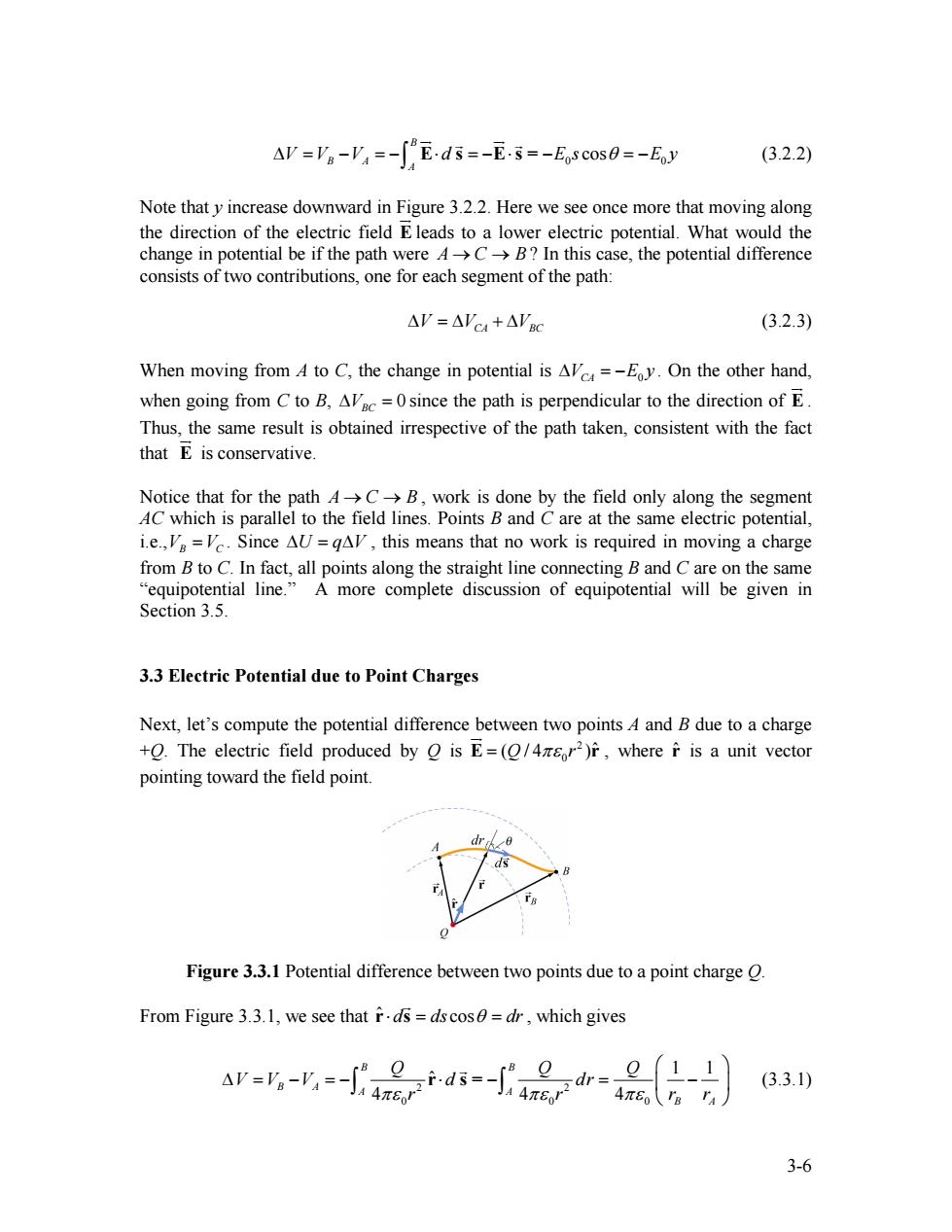正在加载图片...

AV=V。-V4=-∫Eds=-Es=-E.scos0=-Ey (3.2.2) Note that y increase downward in Figure 3.2.2.Here we see once more that moving along the direction of the electric field E leads to a lower electric potential.What would the change in potential be if the path were A->C>B?In this case,the potential difference consists of two contributions,one for each segment of the path: AV=△'c4+A'C (3.2.3) When moving from A to C,the change in potential is Alc=-Eoy.On the other hand, when going from Cto B.AVc=0since the path is perpendicular to the direction of E. Thus,the same result is obtained irrespective of the path taken,consistent with the fact that E is conservative. Notice that for the path 4->C->B,work is done by the field only along the segment AC which is parallel to the field lines.Points B and C are at the same electric potential, i.e.,V=Vc.Since AU=gAv,this means that no work is required in moving a charge from B to C.In fact,all points along the straight line connecting B and C are on the same "equipotential line."A more complete discussion of equipotential will be given in Section 3.5. 3.3 Electric Potential due to Point Charges Next,let's compute the potential difference between two points A and B due to a charge +The electric field produced by o is E=(Q/4zr2)r,where i is a unit vector pointing toward the field point. dr, Figure 3.3.1 Potential difference between two points due to a point charge O. From Figure 3.3.1,we see that r.ds ds cos=dr,which gives ar=--r8d-2r-品-司 (3.3.1) 3-60 cos B B A A ∆V V=−= V − ⋅ d = − ⋅ −E s θ = −E y ∫ E s E s = 0 JG JG G G (3.2.2) Note that y increase downward in F gure 3.2.2. Here we see once more that moving along the direction of the electric field E i JG leads to a lower electric potential. What would the change in potential be if the path were ? In this case, the potential difference consists of two contributions, one for each segment of the path: A C → → B ∆V V = ∆ CA + ∆VBC (3.2.3) When moving from A to C, the change in potential is VCA E0 ∆ = − y . On the other hand, when going from C to B, ∆VBC = 0 since the path is perpendicular to the direction of E JG . Thus, the same result is obtained irrespective of the path taken, consistent with the fact that E JG is conservative. Notice that for the path , work is done by the field only along the segment AC which is parallel to the field lines. Points B and C are at the same electric potential, i.e., . Since , this means that no work is required in moving a charge from B to C. In fact, all points along the straight line connecting B and C are on the same “equipotential line.” A more complete discussion of equipotential will be given in Section 3.5. A C → → B VB =VC r ∆ = U q∆V 3.3 Electric Potential due to Point Charges Next, let’s compute the potential difference between two points A and B due to a charge +Q. The electric field produced by Q is 2 0 E = ( / Q 4πε r )ˆ JG , where is a unit vector pointing toward the field point. rˆ Figure 3.3.1 Potential difference between two points due to a point charge Q. From Figure 3.3.1, we see that r s ˆ ⋅ d d = s cosθ = dr G , which gives 2 2 0 0 0 1 1 ˆ 4 4 4 B B B A A A B A Q Q Q V V V d dr πε r r πε πε ⎛ ⎞ ∆ = − = − ⋅ − = ⎜ − ⎝ ⎠ ∫ ∫ r s =G r r ⎟ (3.3.1) 3-6